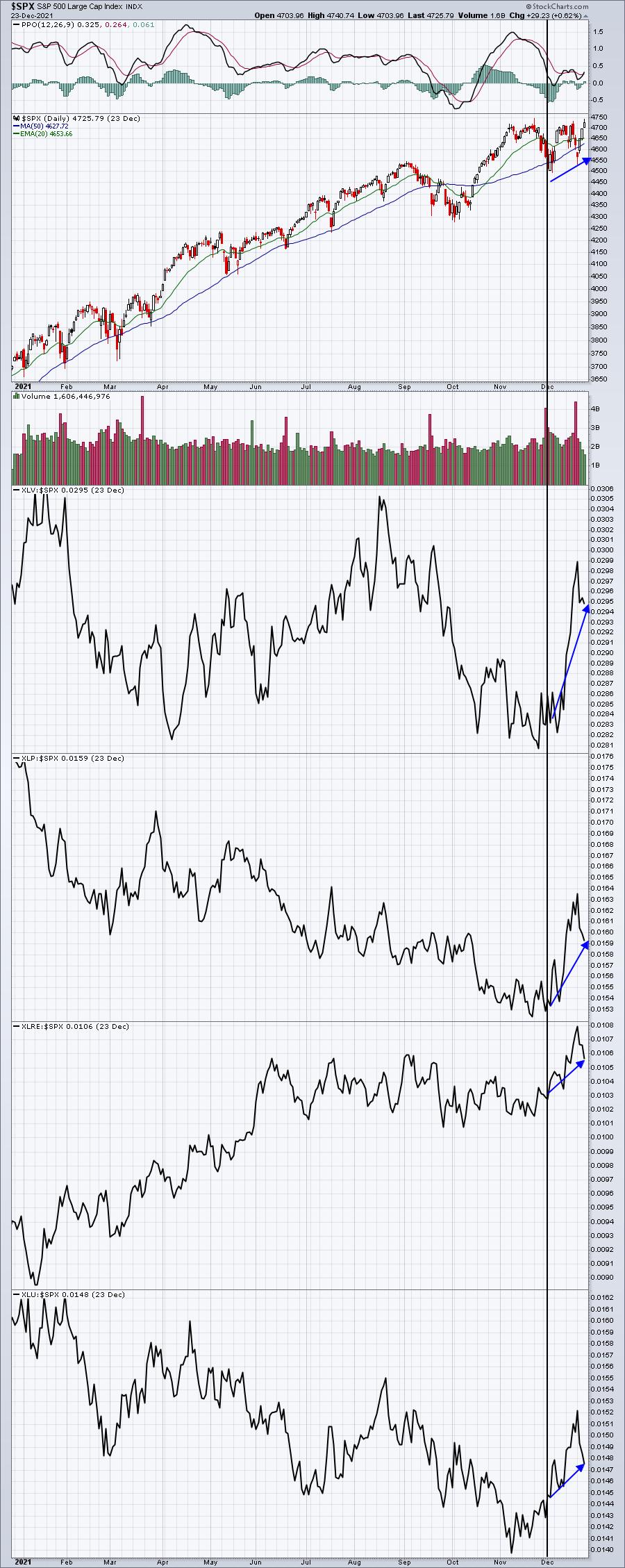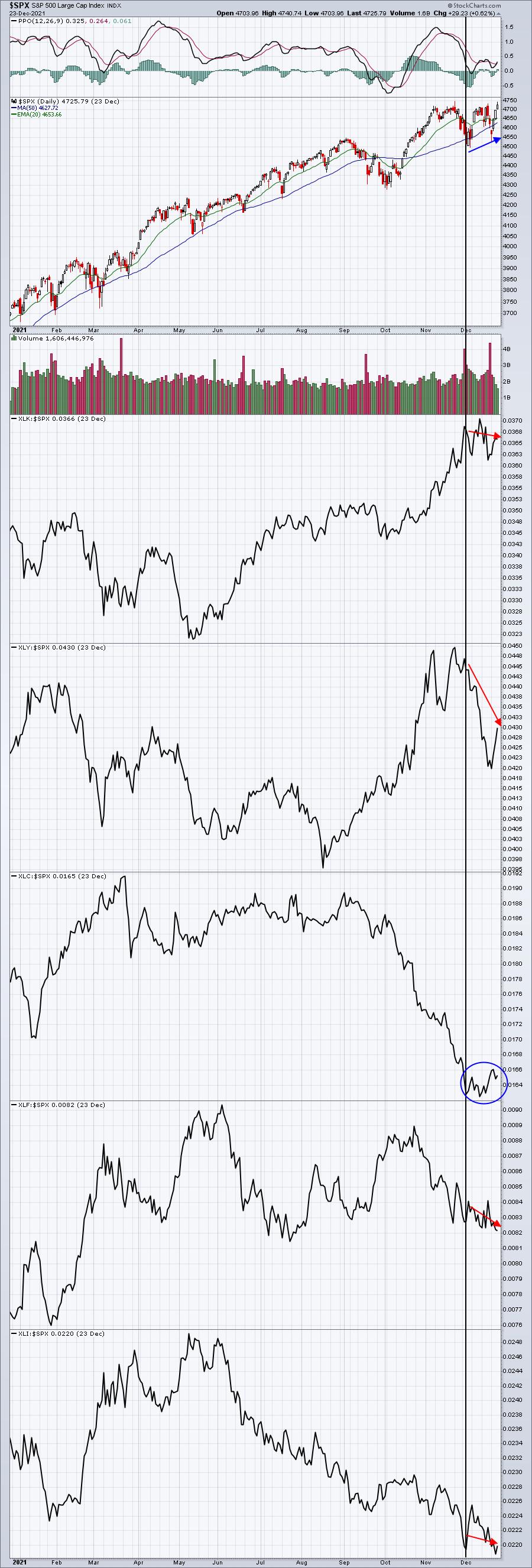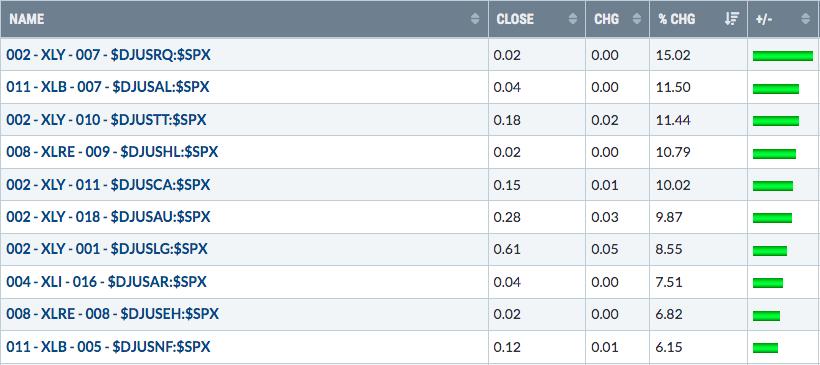It might take more than Old Saint Nick to sustain this current stock market rally. I'm not a believer this year. It reminds me of that catchy holiday tune:
"StockCharts is making a chart and I've checked it twice, gonna find out that Wall Street's naughty, not nice."
The S&P 500 closed on Friday at 4725, its highest close EVER. That's bullish, right? On the surface, it's very bullish, but the stock market truth doesn't always lie on the surface. As technicians, we need to learn to dig deeper. as that's where the problems can reside. And, in my opinion, we have an issue that needs to be resolved quickly.
Many times, a final rally occurs as Wall Street rotates from offense to defense. That seems to be the case currently. The following charts of the S&P 500 show the rally back to new highs, but make sure you check out the relative strength of the various sectors -- first the defensive, then the offensive:
S&P 500 vs. Defensive Sectors:

The latest market rally has been spurred by defensive groups. This chart shows us definitively that Wall Street is favoring defensive groups as the market sets a new high. That's a warning signal and one that I take very seriously. Should the S&P 500 continue to perform well next week, I'd refer to these charts. To sustain the rally, we need to see aggressive groups take the lead on a relative basis. Here's the latest relative chart on those aggressive groups:
S&P 500 vs. Aggressive Sectors:

Technology (XLK) and consumer discretionary (XLY) held this rally together for much of 2021, but that black vertical line marks the most recent market low. The rally off of that low is to the right of the line. The blue circle shows that communication services (XLC) has seen a bit of a dead cat relative bounce, but the other 4 aggressive groups saw relative weakness during this latest surge in equities. That's not what we want to see. Wall Street doesn't move into defensive areas on a relative basis for no reason whatsoever. Many times, it will precede a volatile period ahead. Higher volatility typically results in lower equity prices.
It's time to question the sustainability of this rally.
Let me be very clear that I remain EXTREMELY bullish in the longer-term. I view this current rotation as a short-term, or possibly a medium-term, warning sign. I see much, much higher prices ahead and so, from a long-term buy and hold perspective, I'd keep my long positions intact. But as a short-term trader, I grow more conservative when I see those short-term storm clouds rolling in.
Is omicron the problem? I say absolutely not. When I want to know the severity of COVID and all of its variants, the last place I go is to a media website. They'll scare the heck out of us in order to gain more CLICKS. That's how they make money (larger audience draws in more advertising, so reading their headlines and stories is generally a great big waste of time). Would you like to know where I go for my news? StockCharts.com. Every chart tells me a story. And while you cannot always trust what someone says, especially when it comes to Wall Street firms, I do trust decisions relating to the allocation of resources.
Do you recall the groups that were absolutely crushed during the initial stages of the pandemic? Recreational services ($DJUSRQ) and travel & tourism ($DJUSTT) were two of the hardest hit industry groups during 2020. I initially tracked a Pandemic Index that I created using the User-Defined Indexes here at StockCharts.com. These two industries were included as part of my Pandemic Index. It was very clear to me that COVID-19 was going to present considerable headwinds for both of these industries, and it did.
I'm not getting the same message right now. The omicron variant has begun to surge over the past month. That part is a fact, not really open to interpretation. Much of the current rally occurred this past week. Do you know the groups that led last week's rally? There are 104 industry groups and here were last week's top 10 relative performers:

Look at where Wall Street is allocating its resources! Recreational services (think cruise lines) was the #1 performing industry group last week during this rally. The REAL headlines should read something like this:
"Omicron Variant Surges, But It Won't Affect Travel"
But that is not what we'll see. We'll count hospitalizations and deaths, because that's the part that attracts CLICKS. Listen, I'm not downplaying the virus. COVID is a very serious illness and is a major health care concern. But as history has now proven, it was not a financial concern. And it's even less of a financial concern with omicron, as the resource allocation above tells us. That's the REAL story and the charts tell us the truth.
In addition to the strength in recreational services, check out those other Top 10 industry groups. Travel & tourism ($DJUSTT) was the 3rd best group. Hotel & Lodging REITs ($DJUSHL) and gambling ($DJUSCA) were also in the Top 5. Airlines were 8th. Wall Street is sending us breaking news in the form of resource allocation. On the flip side, it's worth mentioning that 7 of the 9 WORST industry groups last week were in the 5 aggressive sectors, which is extremely unusual during a rally. Can we trust this rally?
The Year Ahead
It's always a challenge to predict what might happen over the course of the coming year, but I've had a pretty good track record in our two previous MarketVision events, which are always held in the first week of the new year. In January 2020, two months before COVID changed our lives, I predicted that the S&P 500 would rise from 3235 to 4040 by December 31, 2020. Of course, there was no way to predict the COVID devastation that sent the S&P 500 plunging to a low of 2191 on March 23, 2020, but, even despite this collapse, we saw the S&P 500 close out 2020 at 3756 - not all that far from my 4040 prediction. I still believe we'd have hit 4000 in 2020 if it weren't for COVID. But we'll never know.
Heading into 2021, I predicted we'd see another huge surge in the S&P 500 to 4750, but that rotation would be the biggest challenge because of the virus. As of Friday's close, the S&P 500 now stands at 4725, just 25 points shy of my earlier prediction. Our high was 4744, so I'll take credit for a solid prediction.
So now comes the prediction for 2022 and our upcoming MarketVision 2022 event. I'll be joined by the following speakers:
- David Keller, Chief Market Strategist, StockCharts.com, and host of The Final Bar
- Grayson Roze, Vice President of Operations, StockCharts.com, and host of StockCharts in Focus
- Bill Shelby, Lead Software Engineer, StockCharts.com, and Scan Engine Extraordinaire
It is going to be another very educational event that everyone should attend. It's an EarningsBeats.com Members-Only event, but here's the good news. You only need to be a FREE 30-day trial member to attend. So, in order to claim your seat, CLICK HERE to get your free 30-day trial membership started! The event will be held on Saturday, January 8th, starting at 8:45am ET. We're working out final details, but it's likely to last just over 4 hours through 1:00pm ET. Those who cannot attend the event live need not worry. We record all of our events and we'll send the recording to all of our members to view at their leisure.
2022 will be an extremely challenging year. I'm not going to spill the beans, but I can say without a doubt that I'm not as bullish heading into 2022 as I was in 2020 or 2021. I hope to see you there!
Happy trading!
Tom Bowley, Chief Market Strategist, EarningsBeats.com
